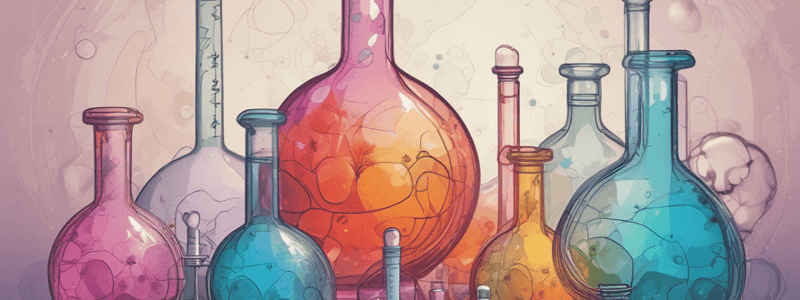Podcast
Questions and Answers
Which characteristic uniquely defines non-metals compared to metals?
Which characteristic uniquely defines non-metals compared to metals?
- Produce a resonating sound
- Brittle and not ductile (correct)
- Good conductors of heat and electricity
- Malleable and ductile
Which of the following elements is classified as a metalloid?
Which of the following elements is classified as a metalloid?
- Iron
- Sodium
- Helium
- Silicon (correct)
What is a common property of noble gases?
What is a common property of noble gases?
- They are reactive with halogens.
- They conduct electricity well.
- They are inert and unreactive. (correct)
- They readily form compounds.
Which of the following elements is not a metal?
Which of the following elements is not a metal?
What is the significance of graphite among non-metals?
What is the significance of graphite among non-metals?
Which statement accurately describes an element?
Which statement accurately describes an element?
What distinguishes pure substances from impure substances?
What distinguishes pure substances from impure substances?
Which of the following accurately describes the nucleus of an atom?
Which of the following accurately describes the nucleus of an atom?
Which particle is negatively charged and orbits around the nucleus of an atom?
Which particle is negatively charged and orbits around the nucleus of an atom?
Which of the following is classified as an impure substance?
Which of the following is classified as an impure substance?
What is the smallest unit of an element that can participate in chemical reactions?
What is the smallest unit of an element that can participate in chemical reactions?
What is the atomicity of Ozone?
What is the atomicity of Ozone?
Which element has the molecular formula P4?
Which element has the molecular formula P4?
Which of the following is true about elements?
Which of the following is true about elements?
What is the proper atomicity for inert gases?
What is the proper atomicity for inert gases?
Which of the following combinations forms a molecule of a compound?
Which of the following combinations forms a molecule of a compound?
What is the molecular formula and atomicity of Sulphur?
What is the molecular formula and atomicity of Sulphur?
Which property distinguishes a compound from its constituent elements?
Which property distinguishes a compound from its constituent elements?
What is true about the composition of a compound?
What is true about the composition of a compound?
Which of the following cannot separate the components of a compound?
Which of the following cannot separate the components of a compound?
Which of these compounds contains sulfur?
Which of these compounds contains sulfur?
Which molecular formula represents a compound formed from three different elements?
Which molecular formula represents a compound formed from three different elements?
Which statement about elements is correct?
Which statement about elements is correct?
Flashcards are hidden until you start studying
Study Notes
Elements
- An element is a pure substance consisting of only one type of atom.
- Elements are indivisible and cannot be broken down into simpler substances.
- Common examples include oxygen, hydrogen, nitrogen, and sulfur.
Pure Substances
- Defined as substances with uniform composition and the same particles.
- Exhibit definite chemical and physical properties.
- Examples include sugar, salt, and water.
Impure Substances
- Comprised of two or more different kinds of particles.
- Lack a definite composition and possess variable properties.
- Common instances are milk, soil, and air.
Atom
- The smallest indivisible unit of an element.
- Atoms can engage in chemical reactions and may exist independently.
Structure of an Atom
- Atoms feature a central nucleus containing protons (positively charged) and neutrons (neutral).
- Electrons (negatively charged) orbit around the nucleus in designated paths known as orbits or shells.
Classification of Elements
- Metals:
- Shiny appearance, hard solids, malleable and ductile.
- Good conductors of heat and electricity, with exceptions like sodium and mercury.
- Non-metals:
- Dull, brittle, and non-malleable.
- Poor conductors, with graphite as an exception.
- Metalloids:
- Exhibit mixed properties of metals and non-metals (e.g., Boron, Silicon, Germanium).
- Noble Gases:
- Inert gases that do not react easily, such as Helium, Neon, Argon, Krypton, Xenon, and Radon.
Names and Symbols of Elements
- Example: Iron is derived from the Latin "Ferrum" and is symbolized as Fe.
- Tungsten comes from the German "Wolfram" and is symbolized as W.
Molecule
- The smallest particle of a substance that retains all its properties.
- Same elements form molecules of that element (e.g., H2, O2).
- Different elements combine to form molecules of compounds (e.g., HCl, H2O).
Atomicity
- Refers to the number of atoms in a molecule.
- Metals and noble gases typically have an atomicity of one (monoatomic).
- Examples of molecular formulas and atomicity:
- Hydrogen (H2) has atomicity 2, while Phosphorus (P4) has atomicity 4.
Characteristics of an Element
- Composed solely of one kind of atom.
- Cannot be decomposed into simpler substances through physical or chemical means.
- Each element possesses unique properties.
Compounds
- Comprised of two or more different elements combined chemically in a fixed proportion.
- Examples include:
- Water (H2O)
- Ammonia (NH3)
- Carbon dioxide (CO2)
Characteristics of a Compound
- Elements are chemically bonded in a specific ratio, such as two hydrogen atoms for each oxygen atom in water.
- Compounds have distinct properties that differ from the individual properties of their constituent elements.
- Elements in a compound cannot be separated by physical means, but can be separated chemically, as in the case of water through electrolysis.
Studying That Suits You
Use AI to generate personalized quizzes and flashcards to suit your learning preferences.




